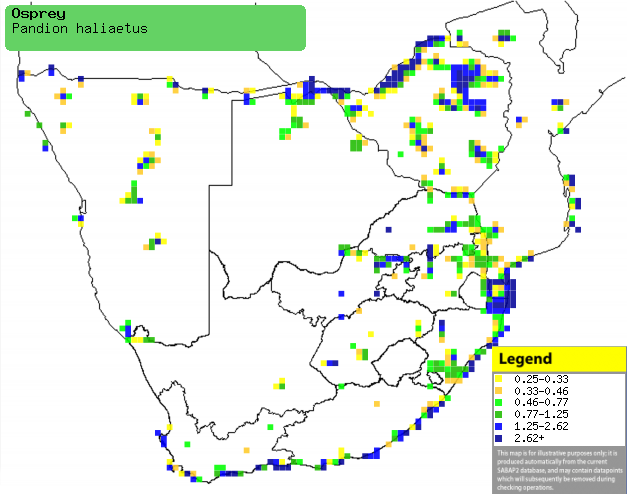|
Pandion haliaetus (Osprey)
Visvalk [Afrikaans]; Visarend [Dutch]; Balbuzard pêcheur
[French]; Fischadler [German]; Águia-pesqueira [Portuguese]
Life
> Eukaryotes >
Opisthokonta
> Metazoa (animals) >
Bilateria >
Deuterostomia > Chordata >
Craniata > Vertebrata (vertebrates) > Gnathostomata (jawed
vertebrates) > Teleostomi (teleost fish) > Osteichthyes (bony fish) > Class:
Sarcopterygii (lobe-finned
fish) > Stegocephalia (terrestrial
vertebrates) > Tetrapoda
(four-legged vertebrates) > Reptiliomorpha > Amniota >
Reptilia (reptiles) >
Romeriida > Diapsida > Archosauromorpha > Archosauria >
Dinosauria
(dinosaurs) > Saurischia > Theropoda (bipedal predatory dinosaurs) >
Coelurosauria > Maniraptora > Aves
(birds) > Order: Falconiformes
> Family: Pandionidae
The Osprey is sometimes placed in the family Accipitridae
where it is placed in its own subfamily that is the sister group to all the
other members of the Accipitridae. Alternatively, it can be placed in its own
family Pandionidae, sister family to the Accipitridae, which is the
classification followed here.
Distribution and habitat
One of the most widespread birds of prey, it occurs on
every continent except Antarctica; in Africa it is partly resident in the
tropics but is a non-breeding visitor pretty much everywhere else, including
southern Africa. Here it is generally uncommon and localised across much of the
region, excluding the arid interior, generally preferring sea shores, estuaries
and lagoons along the coast. Inland it is restricted to lakes, large
rivers and man-made impoundments, such as dams.
|
 |
|
Distribution of Osprey in southern Africa, based
on statistical smoothing of the records from first SA Bird Atlas Project
(©
Animal Demography unit, University of
Cape Town; smoothing by Birgit Erni and Francesca Little). Colours range
from dark blue (most common) through to yellow (least common).
See here for the latest distribution
from the SABAP2. |
Movements and migrations
Mainly a non-breeding migrant to southern
Africa, arriving from October-December and leaving from March-May.
However there are many records of individuals who have stayed in the
region over winter and some may even be resident.
Food
It almost exclusively eats fish, typically hunting by
flying in circles over the water. Once it has spotted a fish it dives into the water feet first, with its wings held back,
sometimes submerging itself completely to catch prey up to about a metre below the
surface. It is more successful when the water is choppy than when it is calm,
probably because prey can spot the Osprey more easily. If it catches a
fish, it rises from the water with wings flapping hard to gain height, shivering
and shaking itself dry before heading back to a favoured perch to feed. The following food items have been recorded
in its diet:
- Fish
- Oreochromis mossambicus (Mozambique tilapia)
- mullet (Mugilidae)
- Lepomis macrochirus (Bluegill sunfish)
- Other
Breeding
- There only four confirmed breeding records in southern Africa, so much of
the following information is from Europe; it is a monogamous, territorial
solitary nester.
- In Europe the nest is built by both sexes, consisting of a large, tower-like platform of sticks and other woody material, up to 1.5
metres high and 1 metre wide. A cup is set into the top of the structure, lined with dry grass.
It can be placed in a variety of sites; in southern Africa it was once found
in a Sycamore fig (Ficus sycomorus).
- Egg-laying season is in spring and summer.
- It lays 1-4 eggs, which are incubated for about 35-43 days.
- The chicks stay in the nest for roughly 50 days.
Threats
Not threatened, although its worldwide population is
gradually decreasing. Its conservation status in southern Africa is uncertain,
but it is not understood why it is so uncommon in the region.
References
-
Hockey PAR, Dean WRJ and Ryan PG 2005. Roberts
- Birds of southern Africa, VIIth ed. The Trustees of the John Voelcker
Bird Book Fund, Cape Town.
|
